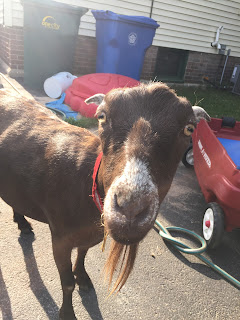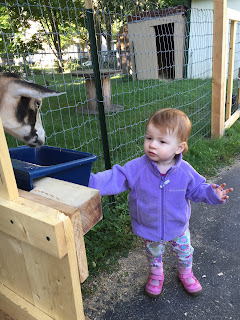It's been a little over a month since I brought the goats home, so how are we doing?
Great!
This journey has had its ups and downs, and the first few weeks were ROUGH, but I couldn't be happier with how everything is going. It took about two weeks for the goats to really settle down and feel comfortable in their new home. Now, they seem very happy and have quieted down a lot.
After the fiasco that was the first few days of milking, I decided to get a milking machine. I got one that was fairly cheap, and probably not the best thing to use since it uses a straight vacuum instead of a pulsating action, which allegedly can damage the udders over time. I used it for a while so the goats and I could get used to each other, but now I don't need it. I can actually milk them faster by hand, and I don't need to clean up all the machine parts, which also saves time.
One thing I've been asked by pretty much everyone who knows about the goats is, "why goats?!" Haha...good question.
I've been enamored with the idea of having a homestead for as long as I can remember. Every so often, I'd start researching various animals and their needs. I certainly always knew I wanted some sort of dairy animal, but I NEVER expected I'd want goats. I actually did NOT want goats, because I couldn't imagine milking a goat. It just seemed odd.
Through my research of milking animals, I found out that cows (and goats) are herd animals, which means you can't just have one. They get very sad and depressed when they're alone. This makes sense, since herds keep prey animals safe, so they probably feel very vulnerable when they're alone. As if having a cow wasn't a big enough undertaking, apparently I needed TWO cows, which seemed impossible. Because of this little hitch, I started looking at goats, and totally fell in love. I watched videos of goats playing, of people milking goats, etc, and my concerns about the oddness of milking a goat diminished. It looked pretty easy! And goats seemed fun. A cow can give 5+ gallons of milk A DAY, which is WAAAYYY more than my little family needs. Goats are much more reasonable for a homestead, since they produce much less. Bigger goats, like nubians, can put out a few gallons a day. Nigerian Dwarfs, which is the breed I settled on, produce more on the order of 2 quarts a day if you get a goat from really good milking lines. Paisley is a Nigerian Dwarf, and I only get about 2 cups a day from her because she's a first freshener (first time she had kids), and I got her in milk so her production probably went down with the trauma of moving homes. Her momma produces almost 2 quarts a day as a second freshener, so I have high hopes for her in the future.
Now that I've had the goats for a month, I honestly don't think getting a cow would ever be worthwhile. The goats produce plenty for our needs, and they're not even producing at their maximum ability. They're smaller and easier to care for, and they're cuddly and friendly. I love going sit out on the swing and letting them out of their pen. They happily come up to me for a good rub down, and nuzzle me a bit. They just bring so much joy, and the satisfaction that I set a goal, worked toward it, and accomplished it.
A Day in the Life
The goats honestly don't take much work. I go out in the morning at 7:30 to milk them. Milking takes about 30 minutes now, though in the beginning it was more like an hour. After I'm finished milking them, I refill their hay container, dump and refill their water, and that's it. Altogether, my morning goat chores take about 45 minutes.
In the mid-afternoon, I go outside and feed them a little salad of spinach, with a dressing of various herbs for nutrition and parasite control, mixed with olive oil and molasses, and topped with sesame seeds. Sometimes I'll also add in a bit of garlic, which is also good for purging parasites. The spinach provides calcium, the sesame seeds are a good source of copper (I live in a deficient area), and the molasses is a source of iron.
They love it.
I also read somewhere online that feeding them small amounts a few times a day vs feeding larger amounts just at milking times increased the fat content in their milk. I'm not sure that's true, but I have noticed that their milk tastes sweeter now than at first. That could be attributed to better nutrition overall, though, so I'm not sure the extra mid-day feeding is responsible or not.
Every other day, when I give them their salad I also clean out their pen. Since I live in the city, and have a small area vs a big farm, I clean up their poop so it doesn't build up. I bought a shop vac just for sucking up the poop.
And, of course, fancy shmancy muck boots.
Cleaning up poop was actually more work than I was expecting. They poop A LOT. 7-10 times a day. Cleaning it up actually isn't so bad, though. The weather has been very nice lately, and it's actually quite enjoyable to be outside.
While I'm out there, I check on their hay again and dump and refill their water again, that way I don't have to do it after the evening milking. The evening milking just takes 30 minutes, then I'm done for the day and can relax!
The first few weeks took some adjusting, kind of like adding a new baby to a family. I had to figure out what to do with the kids while I milked the goats. I had originally intended to have them both outside with me while I milked, but quickly realized that running, screaming children spooked goats, and scared goats tend to dance around and step in/knock over milking buckets. LUCKILY, the little one decided to start sleeping later, and the big one is pretty trustworthy and can stay inside and play. The goats have also settled down a bit and gotten used to my littles, so they don't get as scared now if they're both out at the same time. If my toddler is awake during milking, she has to come outside, because I can't leave a one year old in the house by herself. For the most part, she's OK, but does tend to stick her hands in the goats' feed buckets.
I'm really glad she gets the experience, though. The goats have also forced me to get outside and get the kids outside more, so that's great!
One thing I'm REALLY proud of is Hermione's progress. Hermione looked much worse than I was expecting when I got her. Through my correspondence with her breeder, I honestly thought the breeder sounded knowledgeable, but there's a steep learning curve to goats and humans have to provide for all their nutritional needs since goats can't really browse as large an area as they would need to to provide for themselves. Hermione's coat was very coarse and wiry, her eye membranes were very light indicating anemia (and probably parasites), and she just generally didn't look her best.
I was really questioning if I knew enough about goats to help her, but after a month, she's looking SO GREAT!
Oh so shiny.
Her coat now is sleek, smooth, and shiny--exactly as it should be. I dewormed her and the salad I've been giving provided the nutrients she was lacking. It took a few weeks, but she's really looking great, and it has given me a HUGE confidence boost. I did that, ya'll! I really feel like a good goat momma. :)
Let this be a lesson, though. If you're new to goats, make sure your breeder knows what he/she is doing. It's difficult and stressful to "fix" a sickly goat. Paisley was in great condition, and all I have to do is not ruin her. THAT is fairly easy. So, learn from my mistake. Don't get a goat that doesn't look healthy, because something is off and you're going to have to fix it.
So, it's a month in and we're doing really well! The milk is yummy and sweet, the yogurt is awesome, the goats are cuddly and loving, and I'm rocking this goat mom thing. There are undoubtedly more shenanigans in our future, but for right now, I'm feeling really good about everything!
































